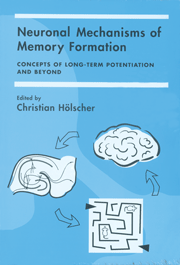Book contents
- Frontmatter
- Contents
- Contributors
- Introduction: Long-Term Potentiation as a Model for Memory Mechanisms: The Story So Far
- Section One Long-Term Potentiation In Vitro and In Vivo: How Can We Fine-Tune the Current Models for Memory Formation?
- Section Two There is More to the Picture Than Long-Term Potentiation: Theta or Gamma Oscillations in the Brain and the Facilitation of Synaptic Plasticity
- Section Three Making Models from Empirical Data of Synaptic Plasticity
- 9 Toward a Physiologic Explanation of Behavioral Data on Human Memory: The Role of Theta-Gamma Oscillations and NMDAR-Dependent LTP
- 10 Neuronal Networks, Synaptic Plasticity, and Memory Systems in Primates
- 11 Revisiting the LTP Orthodoxy: Plasticity versus Pathology
- 12 Long-Term Potentiation and Associative Learning: Can the Mechanism Subserve the Process?
- Section Four Setting the Stage for Memory Formation: Stress, Arousal, and Attention
- Section Five Transgenic Mice as Tools to Unravel the Mechanisms of Memory Formation
- Conclusions and Future Targets
- Index
10 - Neuronal Networks, Synaptic Plasticity, and Memory Systems in Primates
Published online by Cambridge University Press: 13 October 2009
- Frontmatter
- Contents
- Contributors
- Introduction: Long-Term Potentiation as a Model for Memory Mechanisms: The Story So Far
- Section One Long-Term Potentiation In Vitro and In Vivo: How Can We Fine-Tune the Current Models for Memory Formation?
- Section Two There is More to the Picture Than Long-Term Potentiation: Theta or Gamma Oscillations in the Brain and the Facilitation of Synaptic Plasticity
- Section Three Making Models from Empirical Data of Synaptic Plasticity
- 9 Toward a Physiologic Explanation of Behavioral Data on Human Memory: The Role of Theta-Gamma Oscillations and NMDAR-Dependent LTP
- 10 Neuronal Networks, Synaptic Plasticity, and Memory Systems in Primates
- 11 Revisiting the LTP Orthodoxy: Plasticity versus Pathology
- 12 Long-Term Potentiation and Associative Learning: Can the Mechanism Subserve the Process?
- Section Four Setting the Stage for Memory Formation: Stress, Arousal, and Attention
- Section Five Transgenic Mice as Tools to Unravel the Mechanisms of Memory Formation
- Conclusions and Future Targets
- Index
Summary
SUMMARY
Synapse-specific increases and decreases in synaptic strength that depend on the activity of the presynaptic and postsynaptic neuron are central to modern theories of how networks in the brain operate in setting up sensory representations of the world, in memory, and in producing appropriate motor responses. The goals of this chapter are to show how different features of these synaptic modifications are crucial to the operation of different types of network, and to the operation of several different brain systems. The types of network considered will be three that are fundamental to brain function, namely pattern associators, autoassociators, and competitive networks. Each performs a different type of operation for the brain. Then the ways in which these types of synaptic modification are implicated in the operation of the hippocampus and related cortical areas in memory (see the section The Primate Hippocampus), and the cerebral neocortex in visual object recognition (see the section Synaptic Modification Rules) and shortterm memory (see the section Short-Term Memory) will be described. The points made apply to any synapse-specific modification process in the brain, regardless of whether that process happens to be long-term potentiation/depression (LTP/LTD). More formal descriptions of the operation of some of the networks introduced here are provided by Rolls and Treves (1998), and by Hertz et al. (1991). Ways in which these architectures may be specified genetically are suggested by Rolls and Stringer (2000b).
Pattern Associators
A fundamental operation of most nervous systems is to learn to associate a first stimulus with a second that occurs at about the same time, and to retrieve the second stimulus when the first is presented.
- Type
- Chapter
- Information
- Neuronal Mechanisms of Memory FormationConcepts of Long-term Potentiation and Beyond, pp. 224 - 262Publisher: Cambridge University PressPrint publication year: 2000



